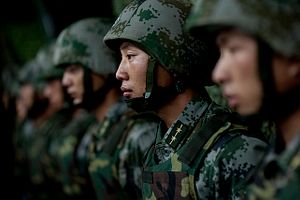On July 11, the official media outlet of the People’s Liberation Army (PLA), China’s armed forces, announced that it will rebalance the two million-strong force by downsizing its army while boosting its navy, missile force, and strategic support force.
According to the PLA Daily, the mouthpiece of the military, the number of PLA Army personnel will be reduced to below one million for the first time in its history. “[T]he old military structure, where the army accounts for the vast majority, will be replaced after the reform,” the announcement said. It added that the PLA Navy, Rocket Force, and Strategic Support Force will see an increase in personnel, while the Air Force’s active service personnel will stay the same.
China’s Ministry of National Defense figures show that the Army had about 850,000 combat troops in 2013. It is unclear exactly how many troops will be cut from the Army given the lack of official data on the total strength of PLA ground forces.
This round of rebalancing fits a trend toward downsizing and rationalizing China’s military that stretch back to the 1980s. The PLA’s size has been cut several times since then — by one million in 1985, 500,000 in 1997, 200,000 in 2003, and, most recently, an announced cut of 300,000 in 2015. The new adjustments to the PLA are not surprising since the Central Military Commission (CMC), which controls all of China’s armed forces, had foreshadowed it earlier. In January 2016, the CMC published an outline of China’s military reform priorities through to 2020. In this document, the CMC called for the continual transformation of the PLA from a “quantitative” to a “qualitative” force, the “optimization of ratios” between services, and the reduction of non-combat military organizations and personnel.
This round of rebalancing fits into the larger context of military reform currently underway in China. The PLA is facing the most sweeping and comprehensive transformation since the 1950s when it was remodeled along Soviet lines after the establishment of the People’s Republic of China. More important than the rebalancing of resources between services are the systemic and institutional changes that are redefining the responsibilities of, and relationships between, the CMC, the service branches, and the five newly established joint Theater Commands (Eastern, Southern, Western, Northern, and Central). It will take years for the new arrangements to be put in place and for the new system to operate effectively.
In addition, in December 2015, China announced the establishment of the PLA Strategic Support Force, a new, independent force under the direct control of the CMC. This new force is responsible for the PLA’s capabilities in the space, cyber, and electromagnetic domains. It may also provide information support to PLA operations. This development highlights the importance of non-traditional domains and high-tech capabilities in PLA’s strategic planning.
Seen within the context of the larger military reform program, this round of troop reduction should not diminish the PLA’s warfighting capabilities. Instead, it aims to make the PLA a leaner and more effective fighting force. As explained by a spokesperson from the Ministry of National Defense in 2015, after troop cuts were announced: “Through the cut of troops’ number, China’s military will further adjust and optimize its scale and structure, make its troops more capable and its structure more scientific, and construct a modern military force.”
There are three ways in which the current rebalancing will feed into a more effective PLA. First, a rebalancing of resources away from the Army to the Navy, Rocket Force, and Strategic Support Force will allow China to better tackle emerging security challenges, including in the maritime and cyber domains. The traditional dominance of land and ground forces in Chinese strategic thinking is no longer tenable in the face of newer security imperatives, such as the need to safeguard sea lanes, enforce maritime claims, conduct overseas operations, and secure information infrastructures.
Second, the reduction will cut fat from the ground forces in the form of non-combat, non-essential personnel, which makes sense from a fiscal point of view. The savings from personnel cuts could be invested into priority areas for the continuing modernization of the PLA, such as training and professional development, researching and development of new capabilities, and improving the integration of its forces.
Third, by reducing the organizational mass of the PLA, China is hoping to make its military more versatile, integrated, and effective. This is especially important given the fast evolving security environment that China is confronted with, including its own growing economic and political footprint around the world.
In sum, the current round of rebalancing is another deliberate step in the long process of making the PLA a leaner and more professional fighting force that can fulfill its growing mission and win modern wars.
Adam Ni is a researcher at the Strategic and Defense Studies Center, Australian National University. His areas of interest include Chinese foreign and security policy. Adam can be found on Twitter @adam_ni.
































